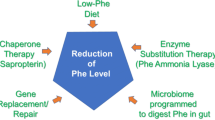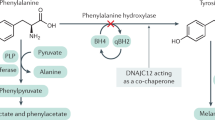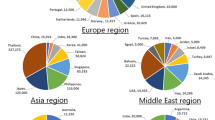Summary
Phenylketonuria (PKU), a Mendelian autosomal recessive phenotype (OMIM 261600), is an inborn error of metabolism that can result in impaired postnatal cognitive development. The phenotypic outcome is multifactorial in origin, based both in nature, the mutations in the gene encoding the l-phenylalanine hydroxylase enzyme, and nurture, the nutritional experience introducing l-phenylalanine into the diet. The PKU story contains many messages including a framework to appreciate the complexity of this disease where phenotype reflects both locus-specific and genomic components. This knowledge is now being applied in the development of patient-specific therapies.
Similar content being viewed by others
Abbreviations
- PKU:
-
phenylketonuria
- PAH :
-
phenylalanine hydroxylase gene
- PAH:
-
phenylalanine hydroxylase
- Phe:
-
phenylalanine
- Tyr:
-
tyrosine
- HPA:
-
hyperphenylalaninaemia
- LSDB:
-
locus-specific database
- PAHdb:
-
phenylalanine hydroxylase locus-specific mutation database
- BH4 :
-
(6R)-l-erythro-5,6,7,8-tetrahydrobiopterin
- LNAA:
-
large neutral amino acids
- PAL:
-
phenylalanine ammonia lyase
- PEG:
-
polyethylene glycol
References
Armstrong MD, Tyler FH (1955) Studies on phenylketonuria. I. Restriction phenylalanine intake in phenylketonuria. J Clin Invest 34: 565–580.
Bernegger C, Blau N (2002) High frequency of tetrahydrobiopterin-responsiveness among hyperphenylalaninemias: A study of 1,919 patients observed from 1988 to 2002. Mol Genet Metab 77: 304–313.
Bickel H, Gerrard J, Hickmans EM (1954) Influence of phenylalanine intake on the chemistry and behaviour of a phenylketonuric child. Acta Paediat 43: 64–77.
Burton BK, Grange DK, Milanowski A, et al (2007) The response of patients with phenylketonuria and elevated serum phenylalanine to treatment with oral sapropterin dihydrochloride (6R-tetrahydrobiopterin): a phase II, multicentre, open-label, screening study. J Inherit Metab Dis 30: 700–707.
Chen L, Woo SL (2005) Complete and persistent phenotypic correction of phenylketonuria in mice by site-specific genome integration of murine phenylalanine hydroxylase cDNA. Proc Natl Acad Sci USA 102: 15581–15586.
Chen L, Woo SL (2007) Correction in female PKU mice by repeated administration of mPAH cDNA using phiBT1 integration system. Mol Ther 15: 1789–1795.
Cristiano RJ, Smith LC, Woo SL (1993) Hepatic gene therapy: adenovirus enhancement of receptor-mediated gene delivery and expression in primary hepatocytes. Proc Natl Acad Sci U S A 90(6): 2122–2126.
Cockburn F, Clark BJ (1996) Recommendations for protein and amino acid intake in phenylketonuric patients. Eur J Pediatr 155(S1): S125–S129.
Cockburn F, Clark BJ, Caine EA, et al (1996) Fatty acids in the stability of neuronal membrane: Relevance to PKU. Int Pediatr 11: 56–60.
Danks DM, Bartholomé K, Clayton BE, et al (1978) Malignant hyperphenylalaninemia - current status (June 1977). J Inherit Metab Dis 1: 49–53.
Dent CE (1957) Relation of biochemical abnormality to development of mental defect in phenylketonuria. Discussion to paper by Armstrong, M.D. In Ross Labs., ed. Report of 23rd Ross Pediatric Research Conference. Etiological Factors in Mental Retardation. Ohio: Ross Labs., 32.
Desviat LR, Perez B, Gámez A, et al (1999) Genetic and phenotypic aspects of phenylalanine hydroxylase deficiency in Spain: molecular survey by regions. Eur J Hum Genet 7: 386–392.
Ding Z, Harding CO, Thöny B (2004) State-of-the-art 2003 on PKU gene therapy. Mol Genet Metab 81: 3–8.
Ding Z, Georgiev P, Thöny B (2006) Administration-route and gender-independent long-term therapeutic correction of phenylketonuria (PKU) in a mouse model by recombinant adeno-associated virus 8 pseudotyped vector-mediated gene transfer. Gene Ther 13: 587–593.
Ding Z, Harding CO, Rebuffat A, Elzaouk L, Wolff JA, Thöny B (2008) Correction of murine PKU following AAV-mediated intramuscular expression of a complete phenylalanine hydroxylating system. Mol Ther 16: 673–681.
Donlon J, Levy H, Scriver CR (2008) Hyperphenylalaninemia: phenylalanine hydroxylase deficiency. In: Valle D, Beaudet A, Vogelstein B, Kinzler K, Antonarakis S, Ballabio A, eds.; Scriver CR, Childs B, Sly WS, emeritus eds. The Metabolic and Molecular Bases of Inherited Disease. New York: McGraw-Hill, Chapter 77. Online. http://genetics.accessmedicine.com.
Eavri R, Lorberboum-Galski H (2007) A novel approach for enzyme replacement therapy. The use of phenylalanine hydroxylase-based fusion proteins for the treatment of phenylketonuria. J Biol Chem 282: 23402–23409.
Eisensmith RC, Woo SL (1996) Gene therapy for phenylketonuria. Eur J Pediatr 155(S1): S16–S19.
Embury JE, Charron CE, Martynyuk A, et al (2007) PKU is a reversible neurodegenerative process within the nigrostriatum that begins as early as 4 weeks of age in Pah(enu2) mice. Brain Res 1127(1): 136–150.
Erlandsen H, Stevens RC (1999) The structural basis of phenylketonuria. Mol Genet Metab 68: 103–125.
Erlandsen H, Stevens RC (2008) Structural studies of phenylalanine hydroxylase enzyme. In Valle D, Beaudet A, Vogelstein B, Kinzler K, Antonarakis S, Ballabio A, eds.; Scriver CR, Childs B, Sly WS, emeritus eds. The Metabolic and Molecular Bases of Inherited Disease. New York: McGraw-Hill, Chapter 77S2. Online. http://genetics.accessmedicine.com.
Erlandsen H, Pey AL, Gamez A, et al (2004) Correction of kinetic and stability defects by the tetrahydrobiopterin in phenylketonuria patients with certain phenylalanine hydroxylase mutations. Proc Nat Acad Sci U S A 101: 16903–16908.
Fang B, Eisensmith RC, Li XH, et al (1994) Gene therapy for phenylketonuria: phenotypic correction in a genetically deficient mouse model by adenovirus-mediated hepatic gene transfer. Gene Ther 1: 247–254.
Fölling A (1934) Uber Ausscheidung von Phenylbrenztraubensaure in den Harn als Stoffwechselanomalie in Verbindung mit Imbezillitat. Hoppe-Seylers Z Physiol Chem 277: 169–176.
Gámez A, Sarkissian C, Wang L, et al (2005) Development of pegylated forms of recombinant Rhodosporidium toruloides phenylalanine ammonia-lyase for the treatment of classical phenylketonuria. Mol Ther 11: 986–989.
Gámez A, Sarkissian CN, Wang L, et al (2008) The changing face of PKU therapy (Part I): What are the options? Abstract. International Conference: Tetrahydrobiopterin, PKU, and NOS. 23–28 March, St. Moritz, Switzerland.
Guldberg P, Rey F, Zschocke J, et al (1998) A European multicenter study of phenylalanine hydroxylase deficiency: classification of 105 mutations and a general system for genotype-based prediction of metabolic phenotype. Am J Hum Genet 63(1): 71–79.
Guthrie R, Susi A (1963) A simple phenylalanine method for detecting phenylketonuria in large populations of newborn infants. Pediatrics 32: 338–343.
Hanley WB, Azen C, Koch R (2004) Matenal Phenylketonuria Collaborative Study (MPKUCS)—the ‘outliers’. J Inherit Metab Dis 27: 711–723.
Hardelid P, Cortina-Borja M, Munro A, et al (2007) The Birth Prevalence of PKU in Populations of European, South Asian and Sub-Saharan African Ancestry Living in South East England. Ann Hum Genet 72(Pt 1): 65–71.
Harding CO (2004) Recent advances in cell and gene therapy for PKU. National PKU News 16: 1–5.
Harding CO, Wild K, Chang D, Messing A, Wolff JA (1998) Metabolic engineering as therapy for inborn errors of metabolism-development of mice with phenylalanine hydroxylase expression in muscle. Gene Ther 5: 677–683.
Harding CO, Gillingham MB, Hamman K, et al (2006) Complete correction of hyperphenylalaninemia following liver-directed, recombinant AAV2/8 vector-mediated gene therapy in murine phenylketonuria. Gene Ther 13: 457–462.
Hodgins DS (1971) Yeast phenylalanine ammonia-lyase. Purification, properties, and the identification of catalytically essential dehydroalanine. J Biol Chem 246: 2977–2985.
Hoskins JA, Holliday SB, Greenway AM (1984) The metabolism of cinnamic acid by healthy and phenylketonuric adults: a kinetic study. Biomed Mass Spectrom 11: 296–300.
Jervis GA (1953) Phenylpyruvic oligophrenia: deficiency of phenylalanine oxidizing system. Proc Soc Exp Biol Med 82: 514–515.
John SW, Rozen R, Scriver CR, Laframboise R, Laberge C (1990) Recurrent mutation, gene conversion, or recombination at the human phenylalanine hydroxylase locus: Evidence in French- Canadians and a catalog of mutations. Am J Hum Genet 46: 970–974.
Kane JF, Fiske JM (1985) Regulation of phenylalanine ammonia lyase in Rhodotorula glutinis. J Bacteriol 161: 963–966.
Kaufman S (1963) The structure of phenylalanine hydroxylation cofactor. Proc Natl Acad Sci U S A 50: 1085–1093.
Kayaalp E, Treacy E, Waters PJ, Byck S, Nowacki P, Scriver CR (1997) Human phenylalanine hydroxylase mutations and hyperphenylalaninemia phenotypes: a metanalysis of genotype–phenotype correlations. Am J Hum Genet 61: 1309–1317.
Koch R, Moseley KD, Yano S, Nelson M Jr, Moats RA (2003) Large neutral amino acid therapy and phenylketonuria: a promising approach to treatment. Mol Genet Metab 79: 110–113.
Kure S, Hou D-C, Ohura T, et al (1999) Tetrahydrobiopterin-responsive phenylalanine hydroxylase deficiency. J Pediatr 135: 375–378.
Kure S, Sato K, Fujii K, et al (2004) Wild-type phenylalanine activity is enhanced by tetrahydrobiopterin supplementation in vivo: an implication for therapeutic basis of tetrahydrobiopterin-responsive phenylalanine hydroxylase deficiency. Mol Genet Metab 83: 150–156.
Kwok SCM, Ledley FD, DiLella AG, Robson KJH, Woo SLC (1985) Nucleotide sequence of a full-length complementary DNA clone and amino acid sequence of human phenylalanine hydroxylase. Biochemistry 24: 556–561.
Leader B, Baca QJ, Golan DE (2008) Protein therapeutics: a summary and pharmacological classification. Nat Rev Drug Discov 7: 21–39.
Ledley FD, Grenett HE, DiLella AG, Kwok SCM, Woo SLC (1985) Gene transfer and gene expression of human phenylalanine hydroxylase. Science 228: 77–79.
Ledley FD, Grenett HE, McGinnis-Shelnutt M, Woo SLC (1986) Retroviral-mediated gene transfer of human phenylalanine hydroxylase into NIH 3T3 and hepatoma cells. Proc Natl Acad Sci U S A 83: 409–413.
Lenke RR, Levy HL (1980) Maternal phenylketonuria and hyperphenylalaninemia. An international survey of untreated and treated pregnancies. N Engl J Med 303: 1202–1208.
Levy HL (1999) Phenylketonuria: old disease, new approach to treatment [comment]. Proc Natl Acad Sci U S A 96: 1811–1813.
Levy HL, Milanowski A, Chakrapani A, et al (2007) Efficacy of sapropterin dihydrochloride (tetrahydrobiopterin, 6R-BH4) for reduction of phenylalanine concentration in patients with phenylketonuria: a phase III randomised placebo-controlled study. Lancet 370: 504–510.
Lichter-Konecki U, Hipke CM, Konecki D (1999) Human phenylalanine hydroxylase gene expression in kidney and other nonhepatic tissues. Molec Genet Metab 67: 308–316.
Lin CM, Tan Y, Lee YM, Chang CC, Hsiao KJ (1997) Expression of human phenylalanine hydroxylase activity in T lymphocytes of classical phenylketonuria children by retroviral-mediated gene transfer. J Inherit Metab Dis 20: 742–754.
Matalon R, Michals-Matalon K, Bhatia G, et al (2006) Large neutral amino acids in the treatment of phenylketonuria (PKU). J Inherit Metab Dis 29: 732–738.
Medical Research Council (UK) (1993) Phenylketonuria due to phenylalanine hydroxylase deficiency: an unfolding story. BMJ 306: 115–119.
Medical Research Council Working Party on Phenylketonuria [Cockburn F, Barwell BE, Brenton DP et al] (1993) Recommendations on the dietary management of phenylketonuria. Report of Medical Research Council Working Party on Phenylketonuria. Arch Dis Child 68: 426–427.
Mitchell JJ, Scriver CR (2007) Phenylalanine hydroxylase deficiency. www.genereviews.org.
Moats RA, Koch T, Moseley K, et al (2000) Brain phenylalanine concentration in the management of adults with phenylketonuria. J Inherit Metab Dis 23: 7–14.
Mochizuki S, Mizukami H, Ogura T, et al (2004) Long-term correction of hyperphenylalaninemia by AAV-mediated gene transfer leads to behavioral recovery in phenylketonuria mice. Gene Ther 11: 1081–1086.
Möller HE, Weglage J, Widermann D, Ullrich K (1998) Blood-brain barrier phenylalanine transport and individual vulerability in phenylketonuria. J Cereb Blood Flow Metab 18: 1184–1191.
Muntau AC, Roschinger W, Habich M, et al (2002) Tetrahydrobiopterin as an alternative treatment for mild phenylketonuria. N Engl J Med 347: 2122–2132.
National Academy of Sciences. Committee for the Study of Inborn Errors of Metabolism DoMSAoLS. 1975. Genetic Screening: Programs, Principles, and Research. Washington, DC: National Academy Press.
National Institutes of Health Consensus Development Panel (2001) National Institutes of Health Consensus Development Conference Statement: Phenylketonuria: Screening and management, October 16–18, 2000. Pediatrics 108: 972–982.
Oltvai ZN, Barabasi AL (2002) Systems biology. Life’s complexity pyramid. Science 298: 763–764.
Penrose LS (1935) Inheritance of phenylpyruvic amentia (Phenylketonuria). Lancet 226: 192–194.
Ramus SJ, Forrest SM, Pitt DB, Saleeba JA, Cotton RGH (1993) Comparison of genotype and intellectual phenotype in untreated PKU patients. J Med Genet 30: 401–405.
Riva E, Agostoni C, Biasucci G, et al (1996) Early breastfeeding is linked to higher intelligence quotient scores in dietary treated phenylketonuric children. Acta Paediatr 85: 56–58.
Salter M, Knowles RG, Pogson CI (1986) Quantification of the importance of individual steps in the control of aromatic amino acid metabolism. Biochem J 234: 635–647.
Santos LL, Magalhães Mde C, Januário JN, Aguiar MJ, Carvalho MR (2006) The time has come: a new scene for PKU treatment. Genet Mol Res 5: 33–44.
Sarkissian CN (2006) Enzyme therapy for PKU. In: Blau N, ed. PKU and BH 4 —Advances in Phenylketonuria and Tetrahydrobiopterin. Heilbronn: SPS Verlagsgesellschaft mbH, 350–369.
Sarkissian CN, Gámez A (2005) Phenylalanine ammonia lyase, enzyme substitution therapy for phenylketonuria, where are we now? Mol Genet Metab 86(Supplement 1): S22–S26.
Sarkissian CN, Shao Z, Blain F, et al (1999) A different approach to treatment of phenylketonuria: phenylalanine degradation with recombinant phenylalanine ammonia lyase. Proc Natl Acad Sci U S A 96: 2339–2344.
Sarkissian CN, Boulais DM, McDonald JD, Scriver CR (2000) A heteroallelic mutant mouse model: a new orthologue for human hyperphenylalaninemia. Mol Genet Metab 69: 188–194.
Sarkissian CN, Gámez A, Wang L, et al (2008) The changing face of PKU therapy (Part II): Who will benefit? Abstract. International Conference: Tetrahydrobiopterin, PKU, and NOS. 23–28 March, St. Moritz, Switzerland.
Scriver CR (1967) Treatment in medical genetics. In: Crow JF, Neel JV, eds. Proceedings of the Third International Congress of Human Genetics. Baltimore: The Johns Hopkins Press, 45–56.
Scriver CR (2007) Wiley 200th Anniversary Tribute Article. The PAH Gene, phenylketonuria, and a paradigm shift. Hum Mut 28: 831–845.
Scriver CR, Waters PJ, Sarkissian C, et al (2000) PAHdb: A locus-specific knowledgebase. Hum Mut 15: 99–104.
Scriver CR, Hurtubise M, Konecki D, et al (2003) PAHdb 2003: What a locus-specific knowledgebase can do. Hum Mutat 21: <H6>333–344.
Scriver CR, Hardelid P, Cortina-Borja M, et al (2006) Did Phenylketonuria (PKU) arise after the Out-of-Africa migration? Am J Hum Genet Abstracts 196 (#995-A).
Shedlovsky A, McDonald JD, Symula D, Dove WF (1993) Mouse models of human phenylketonuria. Genetics 134: 1205–1210.
Smith I (1994) Treatment of phenylalanine hydroxylase deficiency. Acta Paediatr Suppl 407: 60–65.
Snapper I, Yu TF, Chiang YT (1940) Cinnamic acid metabolism in man. Proc Soc Exp Biol Med 44: 30–34.
Spaapen LJ, Rubio-Gozalbo ME (2003) Tetrahydrobiopterin-responsive phenylalanine hydroxylase deficiency, state-of-the-art. Mol Genet Metab 78: 93–99.
Tessari P, Deferrari G, Robaudo C, et al (1999) Phenylalanine hydroxylation across the kidney in humans. Kidney Int 56: 2168–2172.
Treacy E, Pitt JJ, Seller J, Thompson GN, Ramus S, Cotton RGH (1996) In vivo disposal of phenylalanine in phenylketonuria: A study of two siblings. J Inherit Metab Dis 19: 595–602.
Vajro P, Strisciuglio P, Houssin D, et al (1993) Correction of phenylketonuria after liver transplantation in a child with cirrhosis. N Engl J Med 329: 363.
Waters PJ, Parniak MA, Nowacki P, Scriver CR (1998) In vitro expression analysis of mutations in phenylalanine hydroxylase: Linking genotype to phenotype and structure to function. Hum Mutat 11: 4–17.
Weglage J, Moller HE, Wiedermann D, Cipcic-Schmidt S, Zschocke J, Ullrich K (1998a) In vivo NMR spectroscopy in patients with phenylketonuria. Clinical significance of interindividual differences in brain phenylalanine concentrations. J Inherit Metab Dis 21: 81–82.
Weglage J, Wiedermann D, Moller H, Ullrich K (1998b) Pathogenesis of different clinical outcomes in spite of identical genotypes and comparable blood phenylalanine concentration in phenylketonurics. J Inherit Metab Dis 21: 181–182.
Woolf LI, Griffiths R, Moncrieff A (1955) Treatment of phenylketonuria with a diet low in phenylalanine. Br Med J 1: 57–64.
Acknowledgements
The authors thank Dr. Raymond C. Stevens and BioMarin Pharmaceutical Inc. for making this work possible.
Author information
Authors and Affiliations
Corresponding author
Additional information
Communicating editor: Nenad Blau
Competing interests: None declared
References to electronic databases: Phenylketonuria: OMIM +261600. Phenylalanine hydroxylase: EC 1.14.16.1. Phenylalanine ammonia lyase: EC 4.3.1.5. PAHdb, Phenylalanine hydroxylase locus-specific mutation database: www.pahdb.mcgill.ca. GeneReviews: www.genereviews.org.
Rights and permissions
About this article
Cite this article
Sarkissian, C.N., Gámez, A. & Scriver, C.R. What we know that could influence future treatment of phenylketonuria. J Inherit Metab Dis 32, 3–9 (2009). https://doi.org/10.1007/s10545-008-0917-7
Received:
Revised:
Accepted:
Published:
Issue Date:
DOI: https://doi.org/10.1007/s10545-008-0917-7




